SO YOU THINK YOU CAN ARGUE WHAT
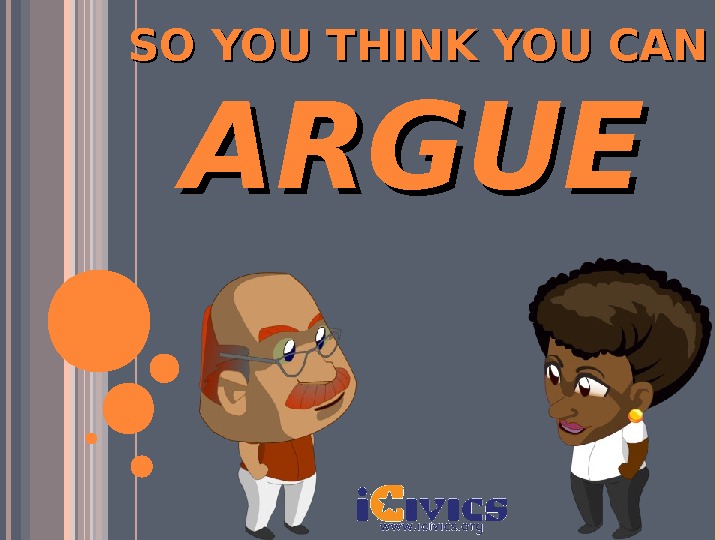
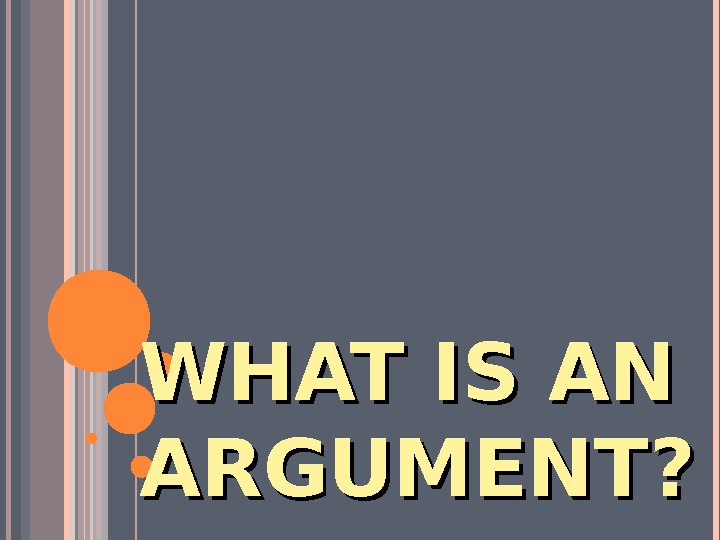

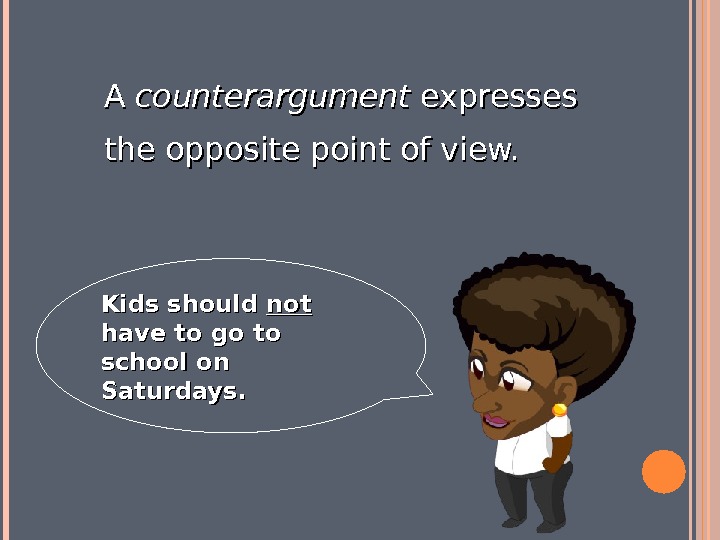
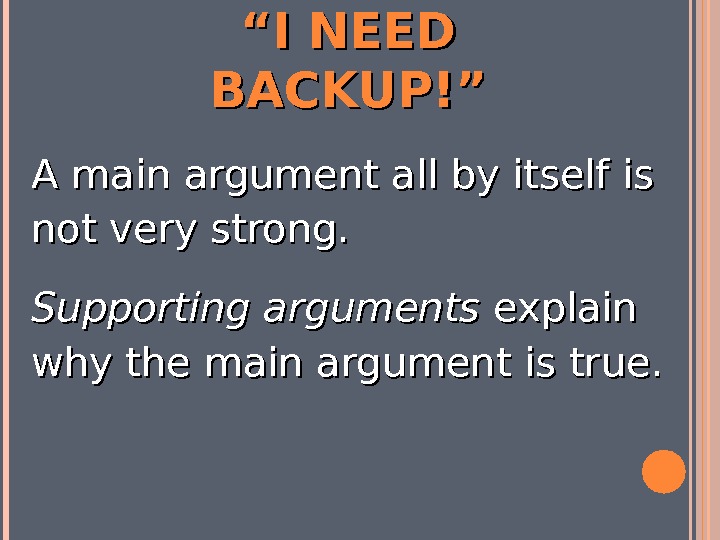
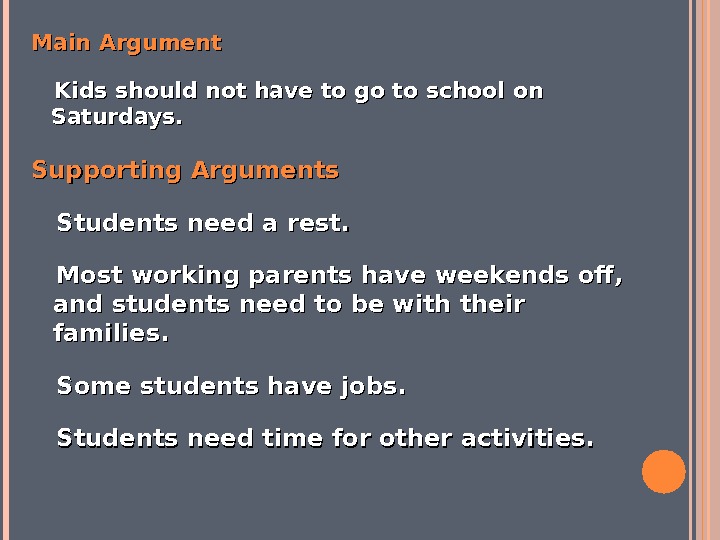

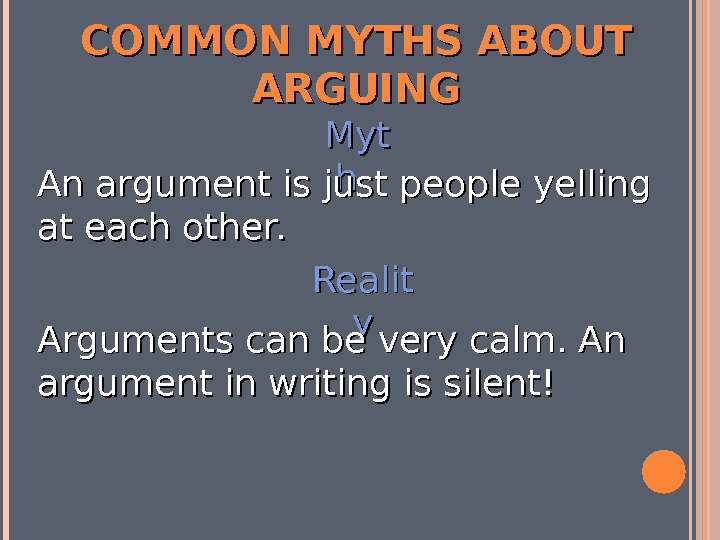
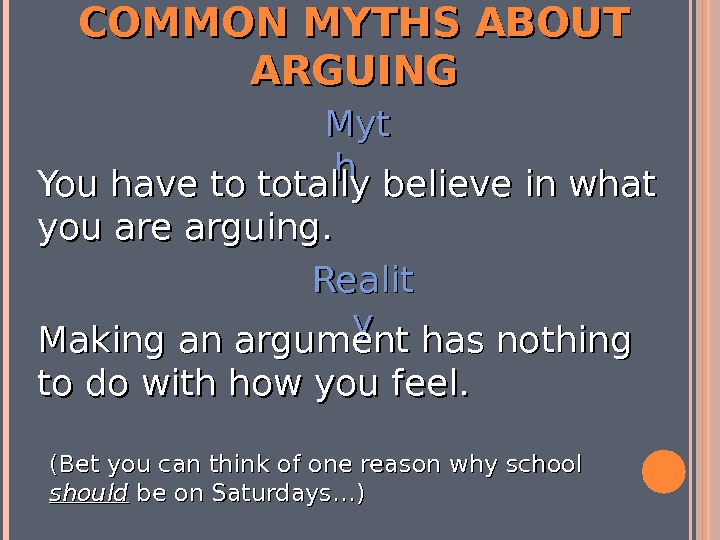
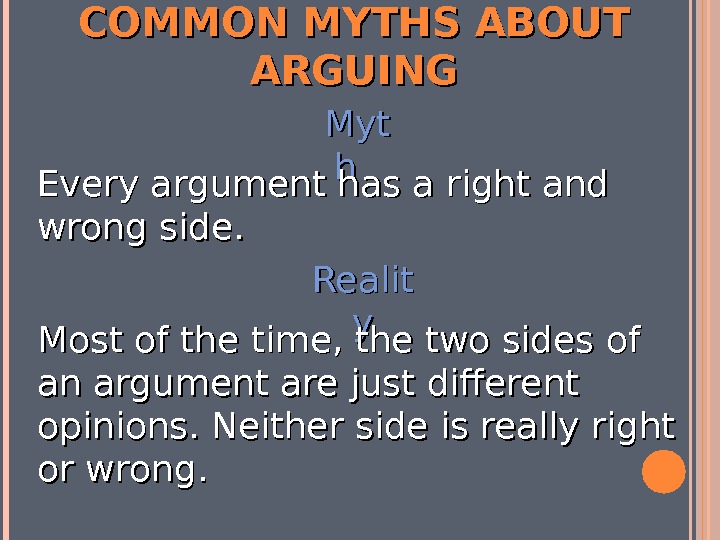
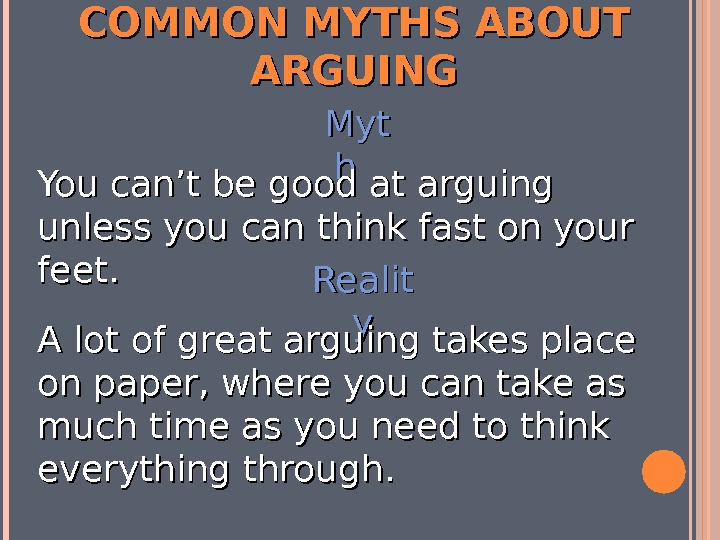

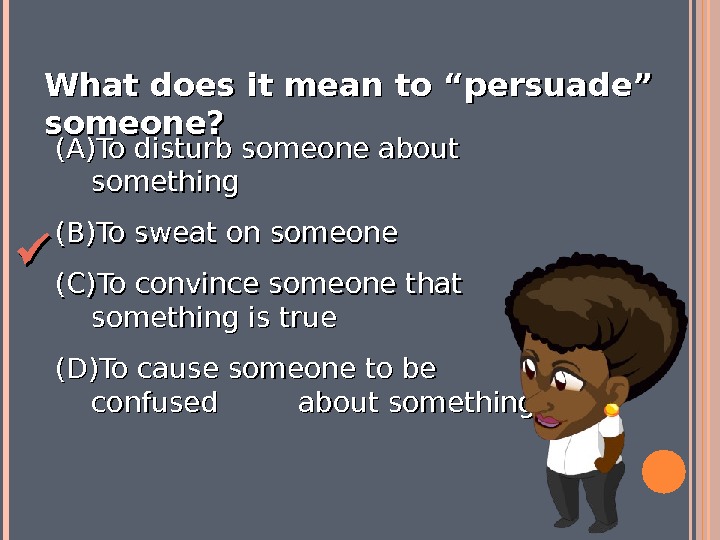
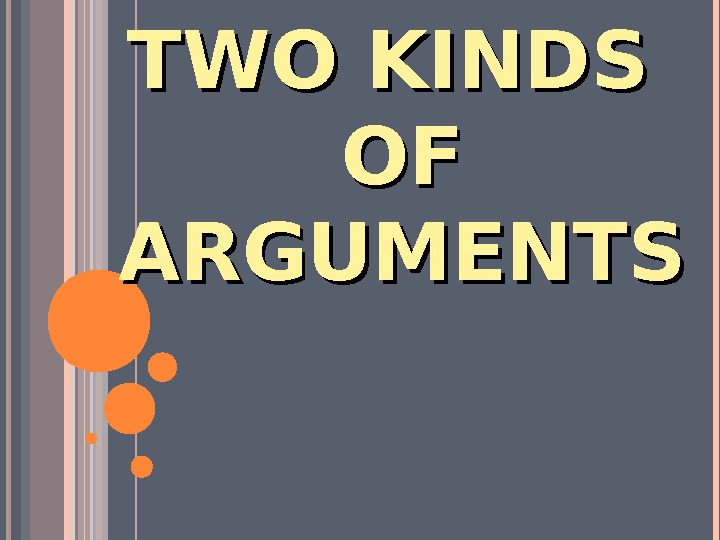
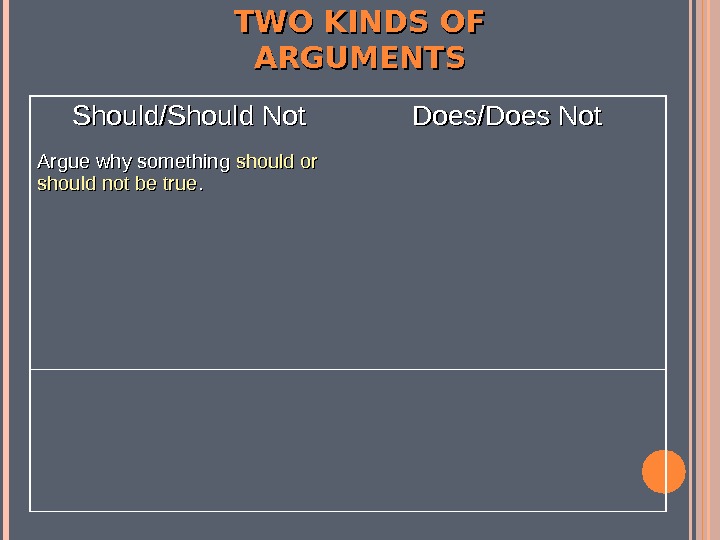
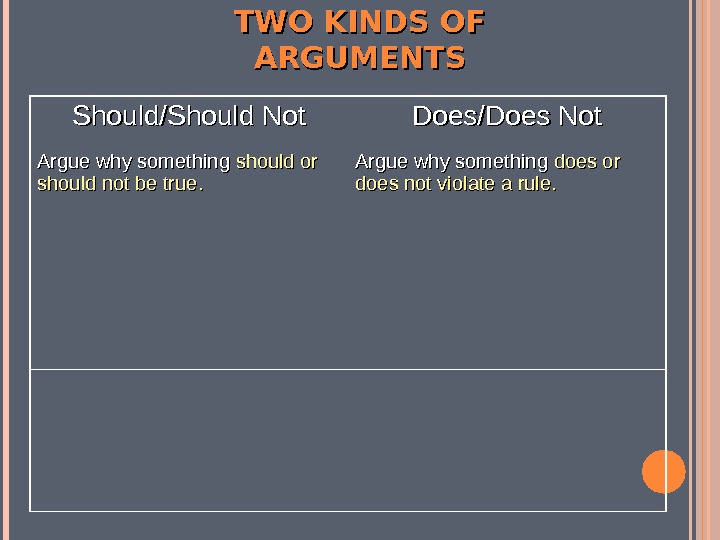
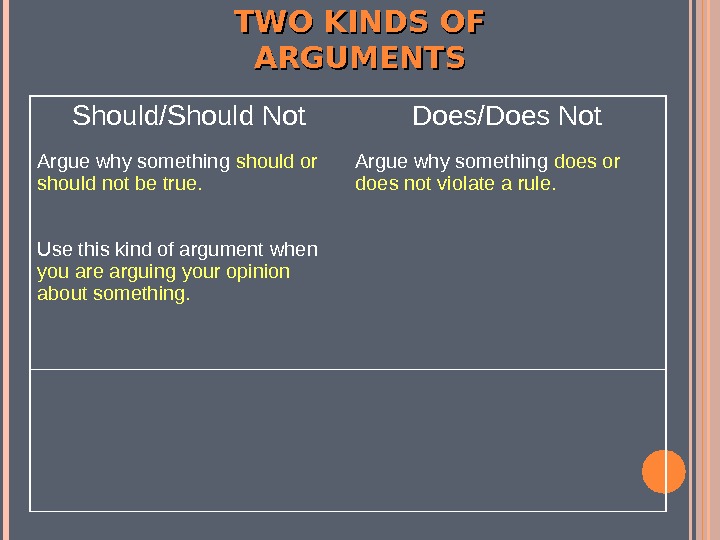
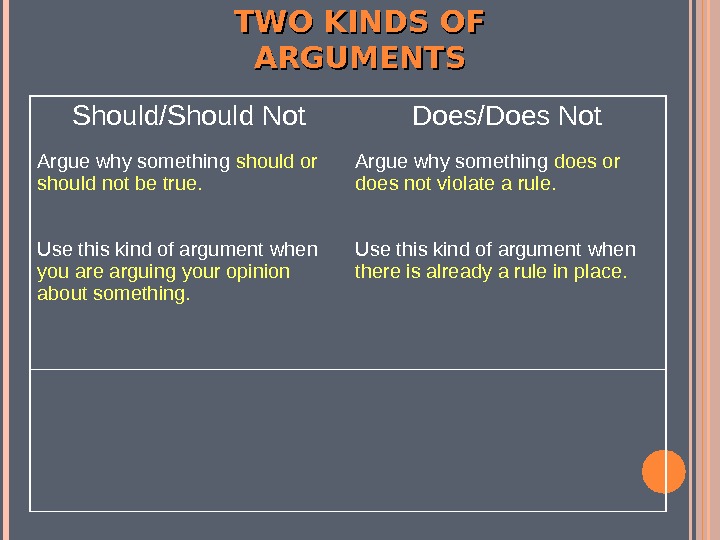
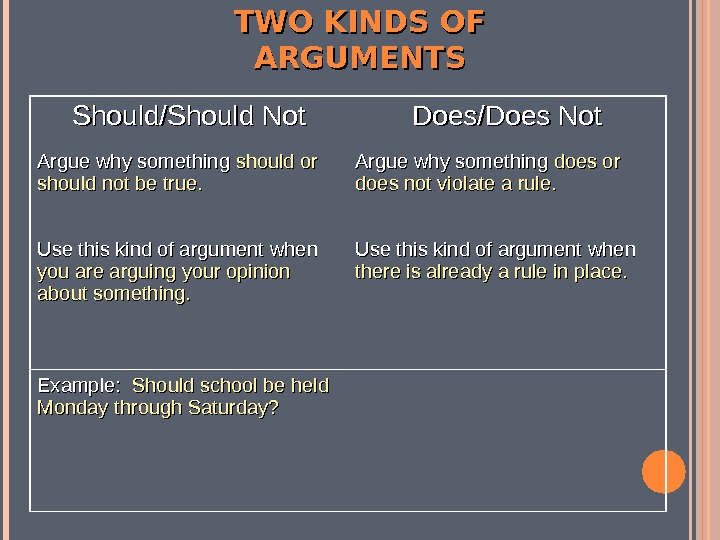
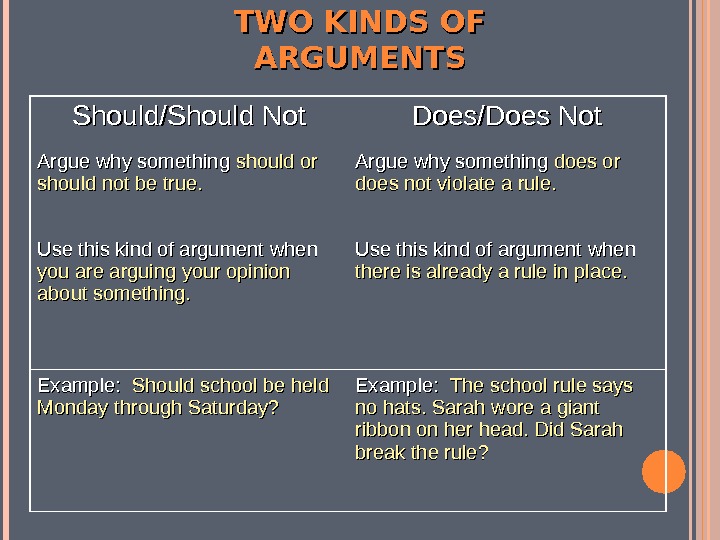
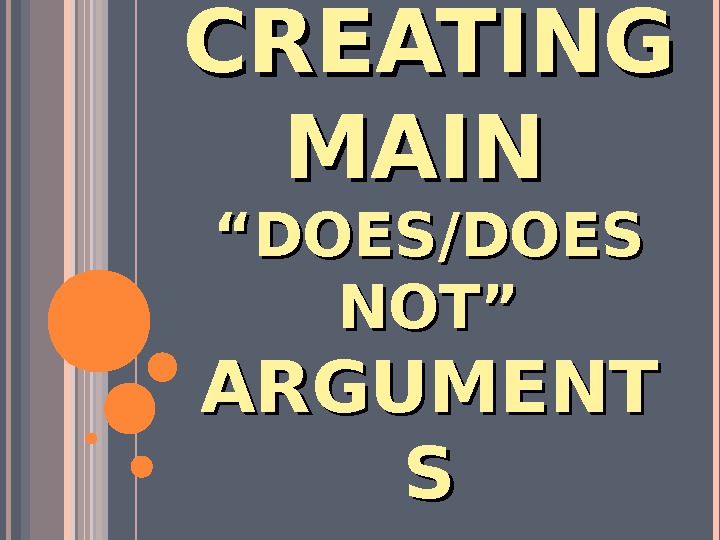
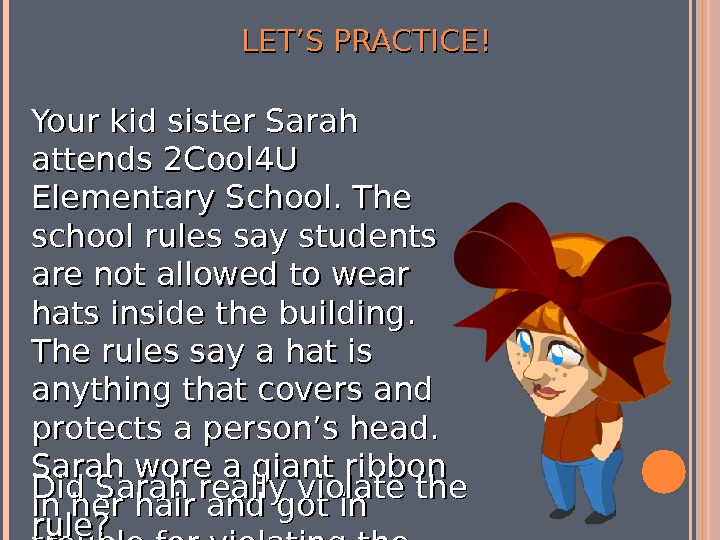
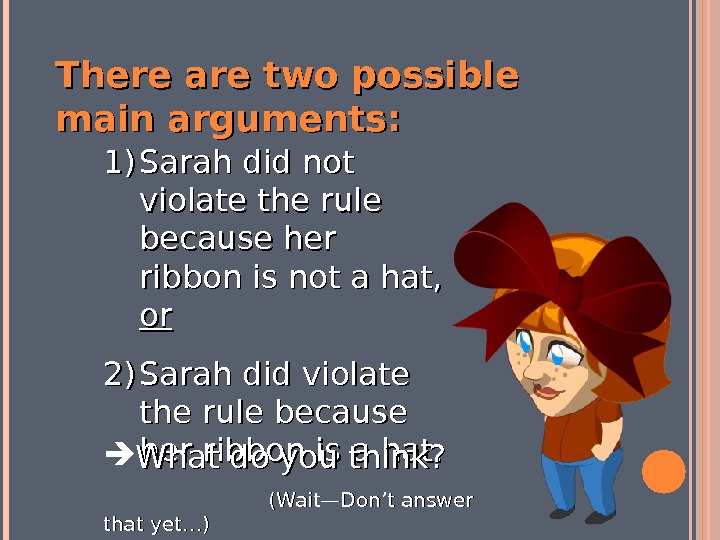

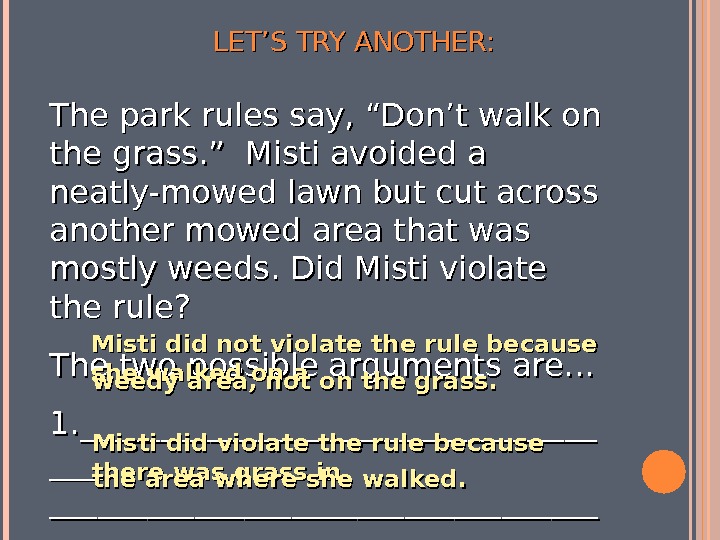
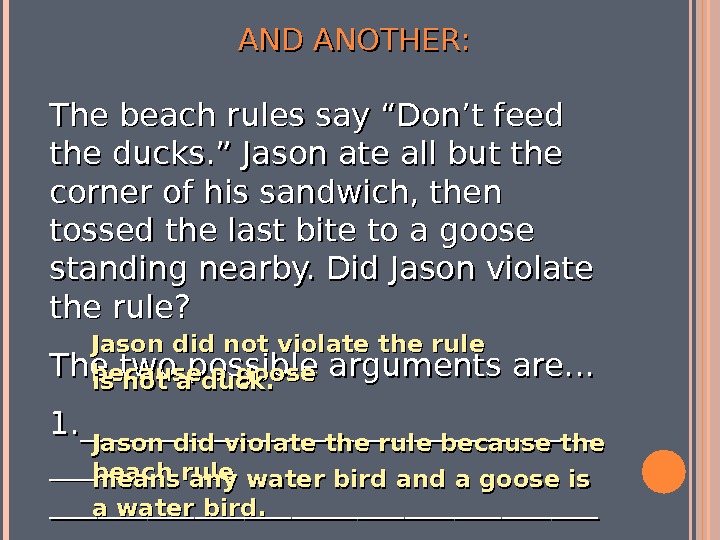
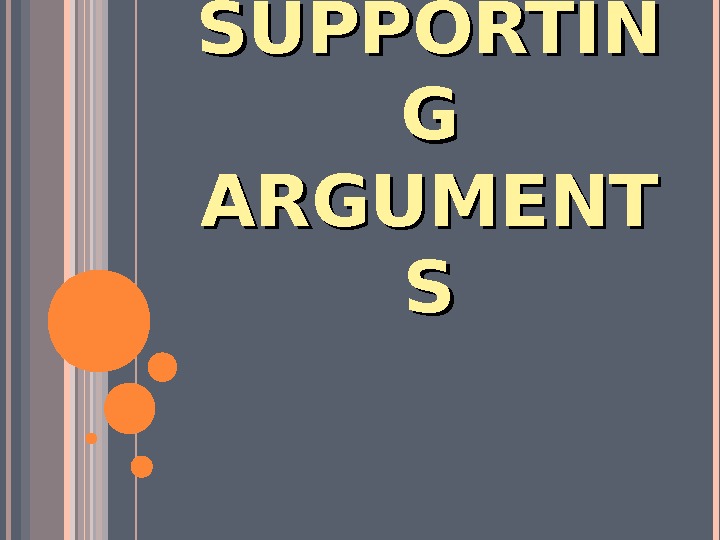
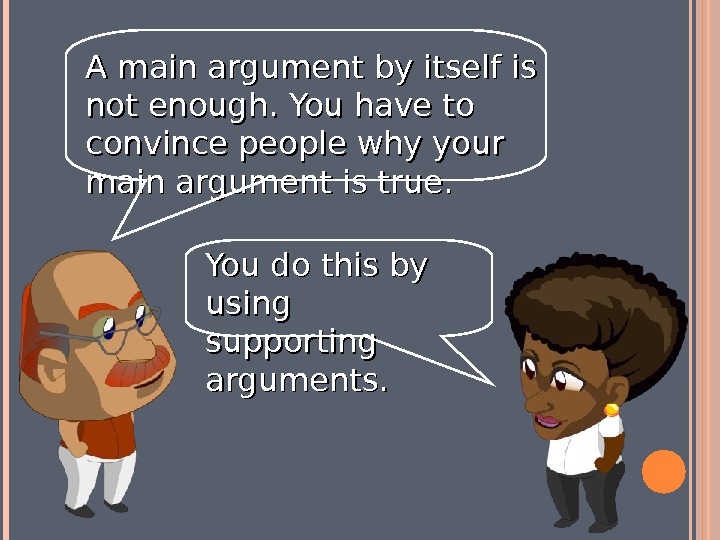

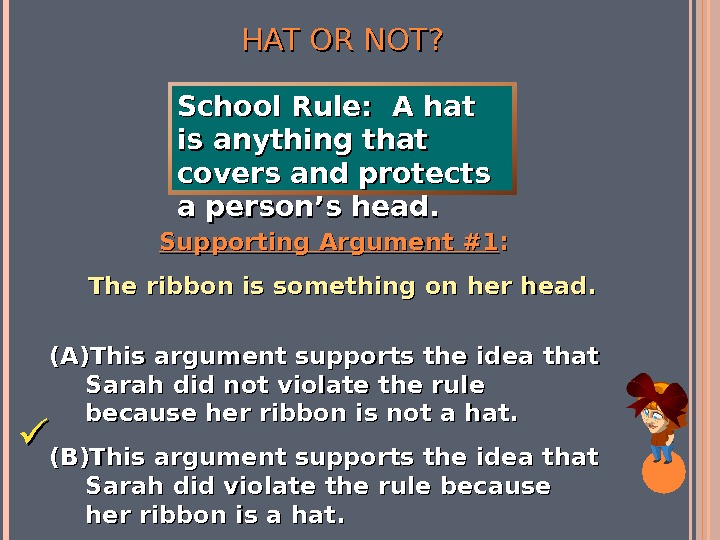
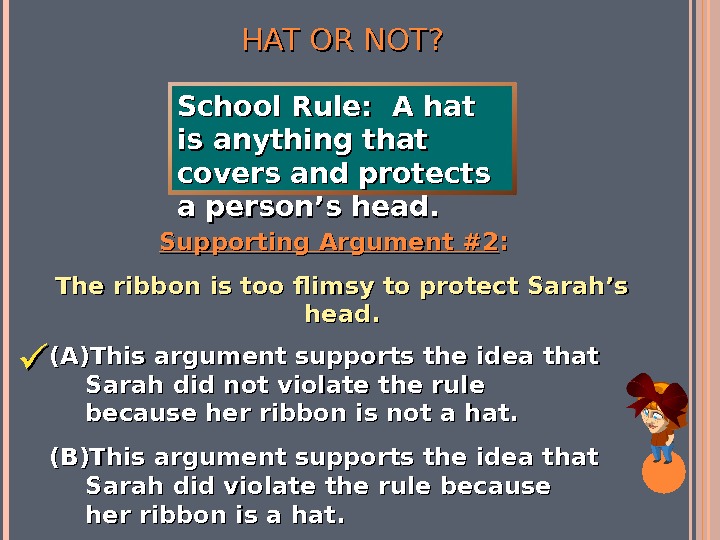
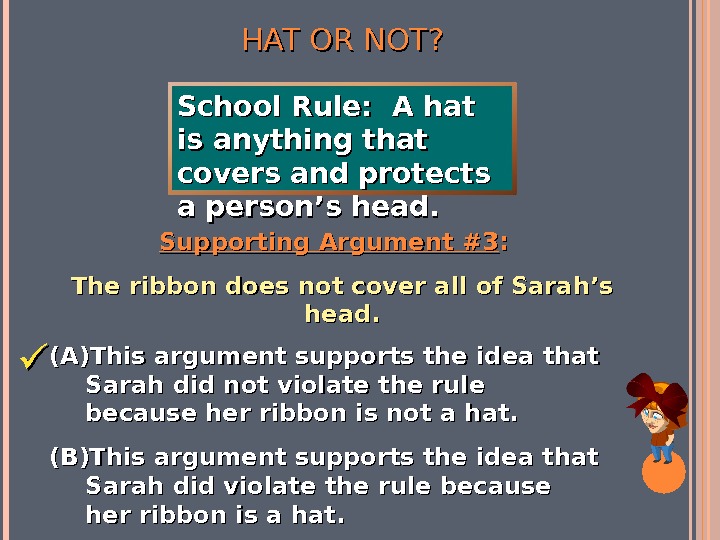
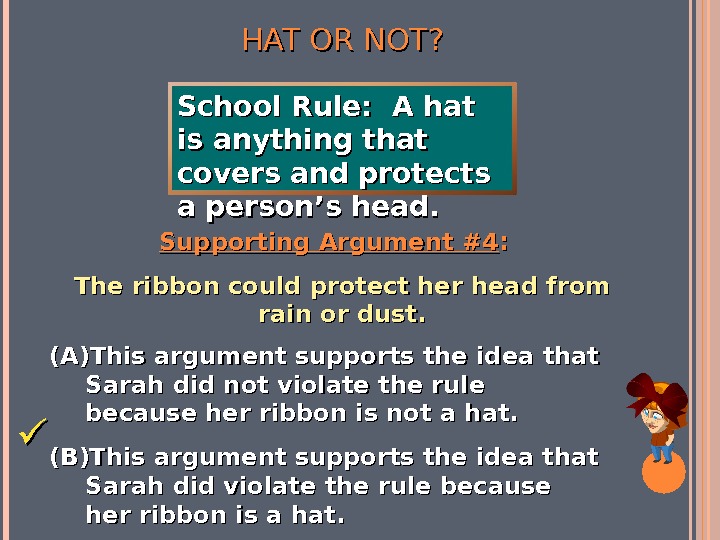
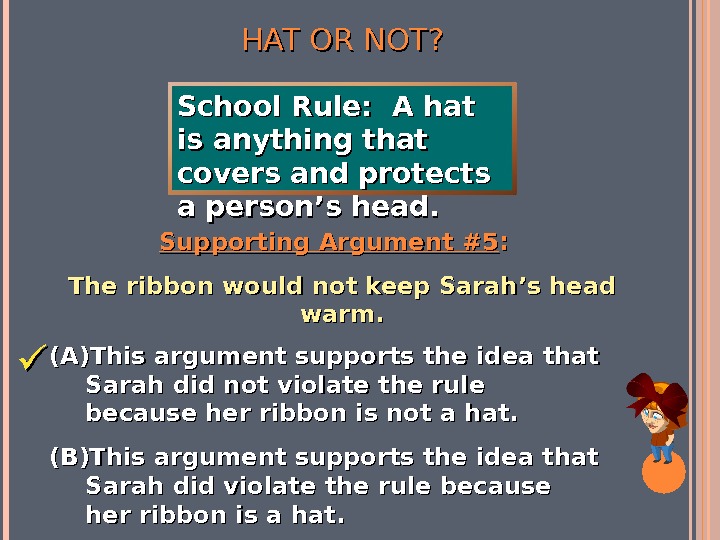
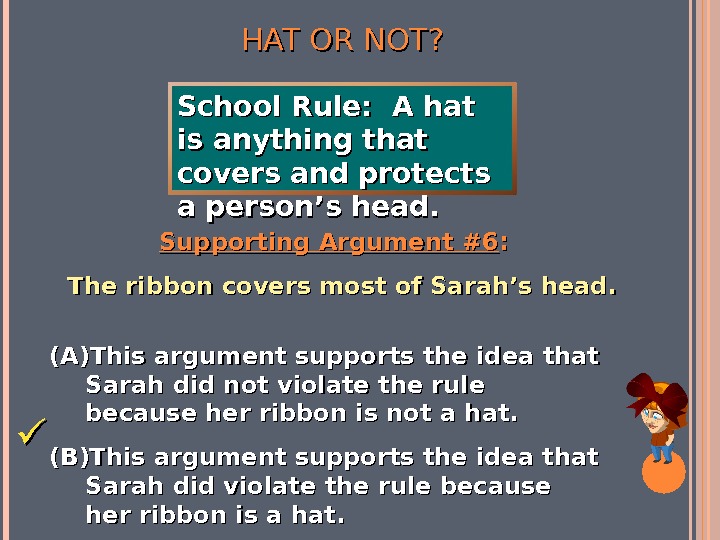


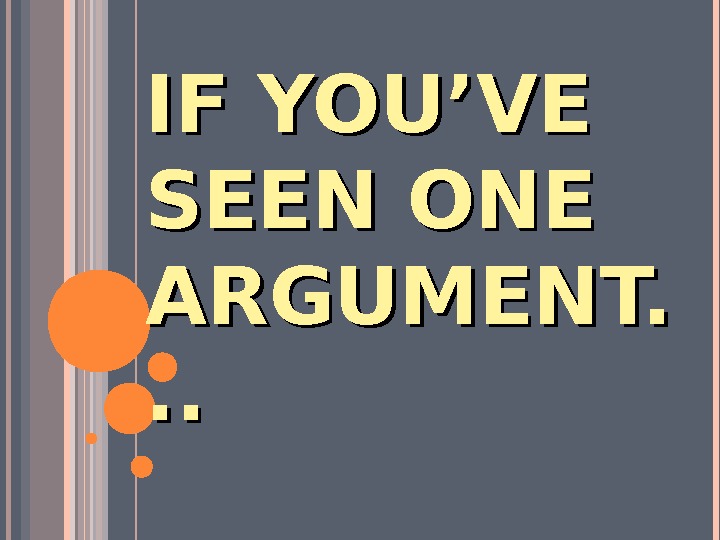
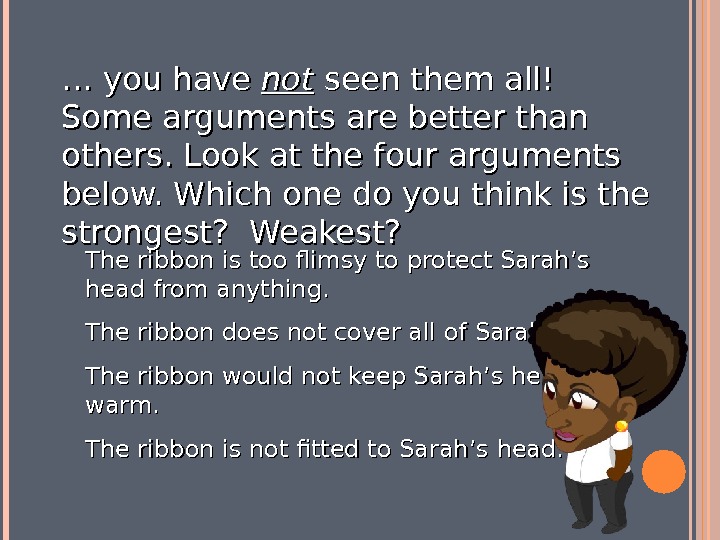
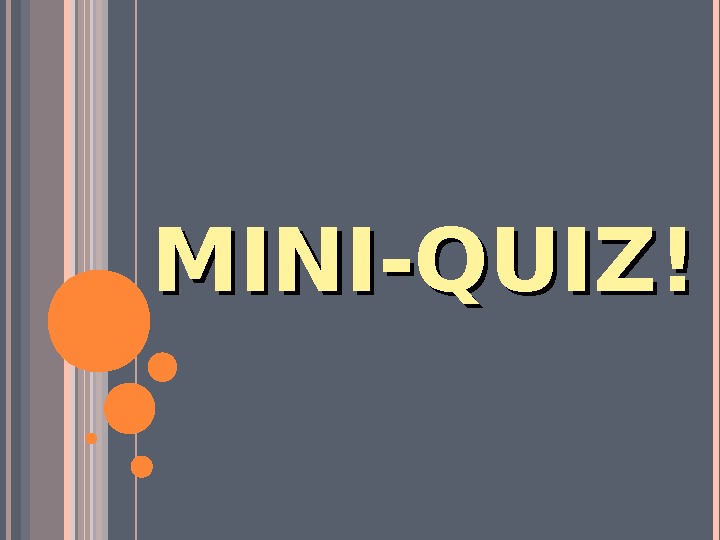
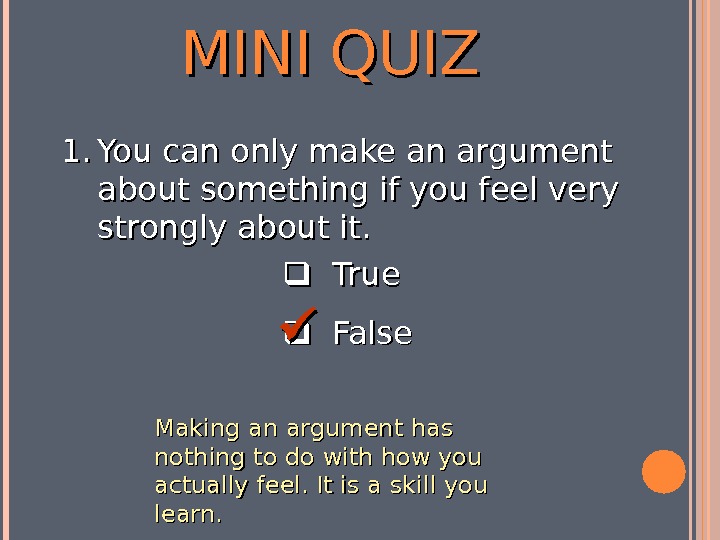

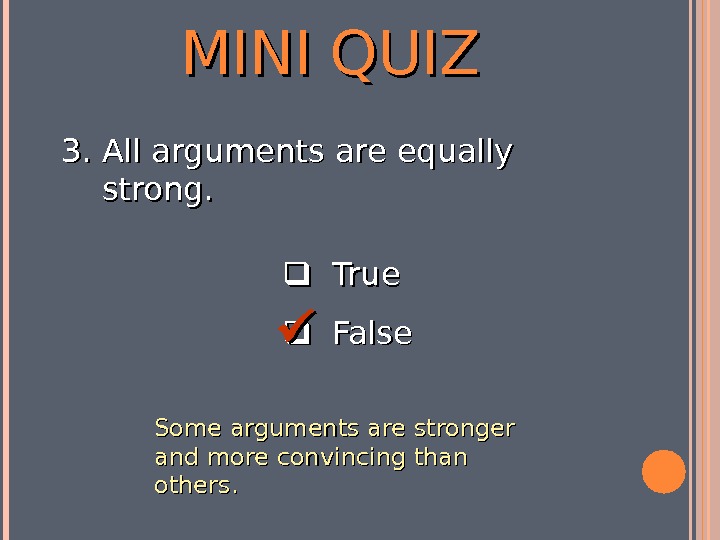
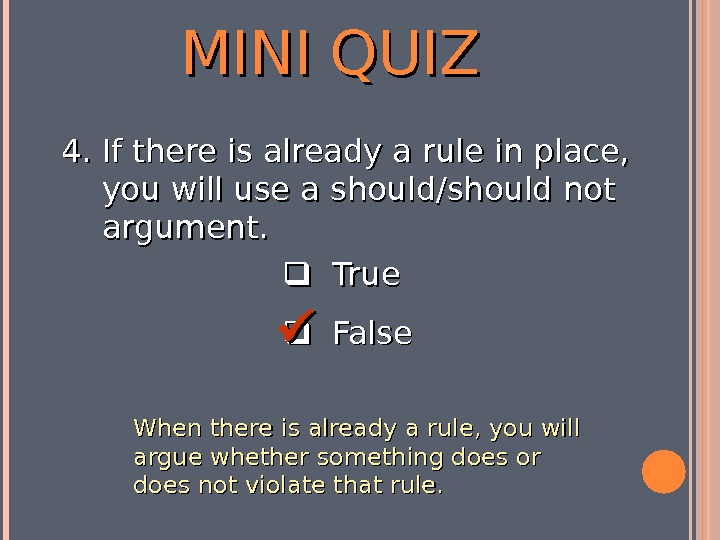
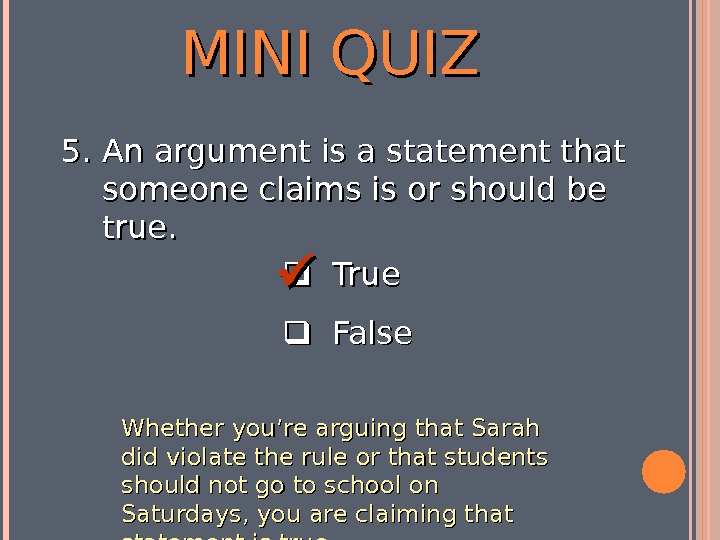
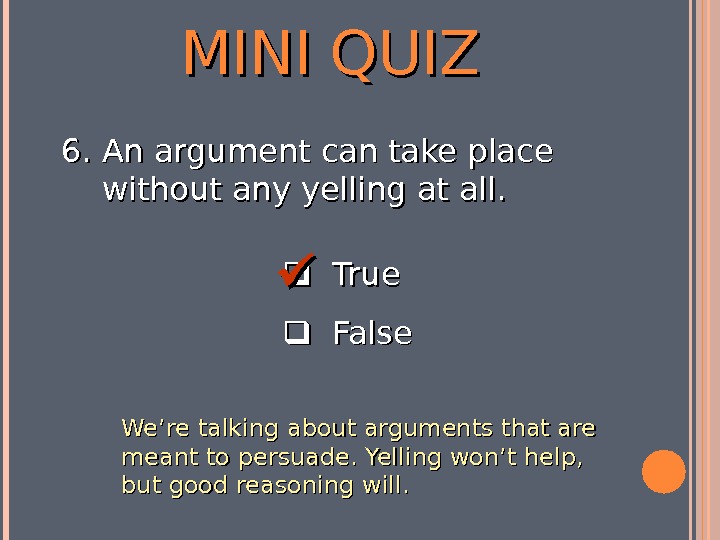
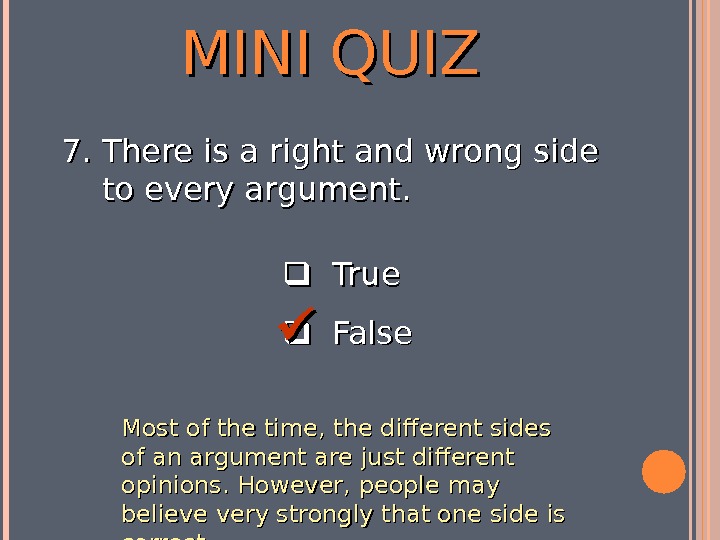
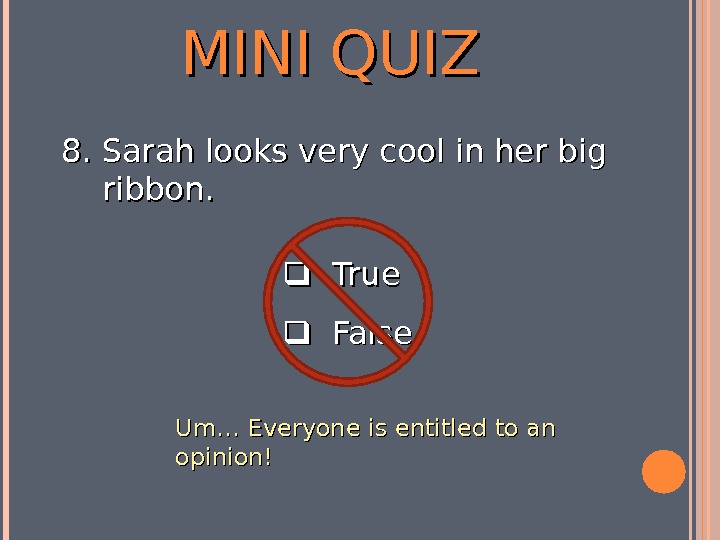
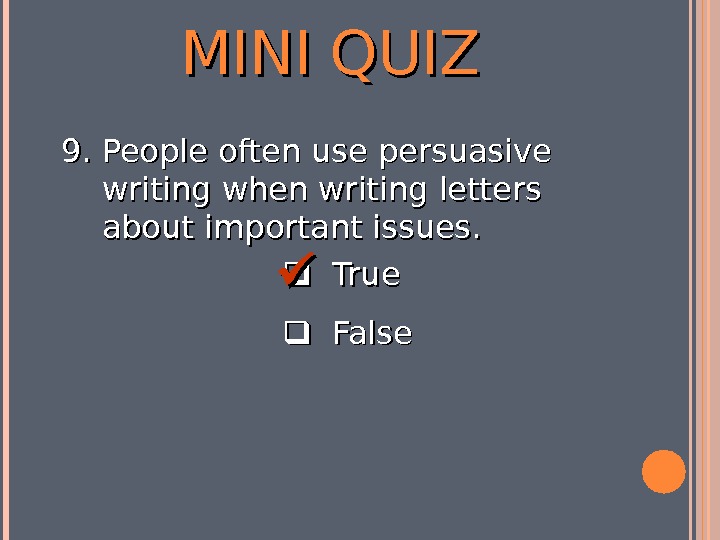
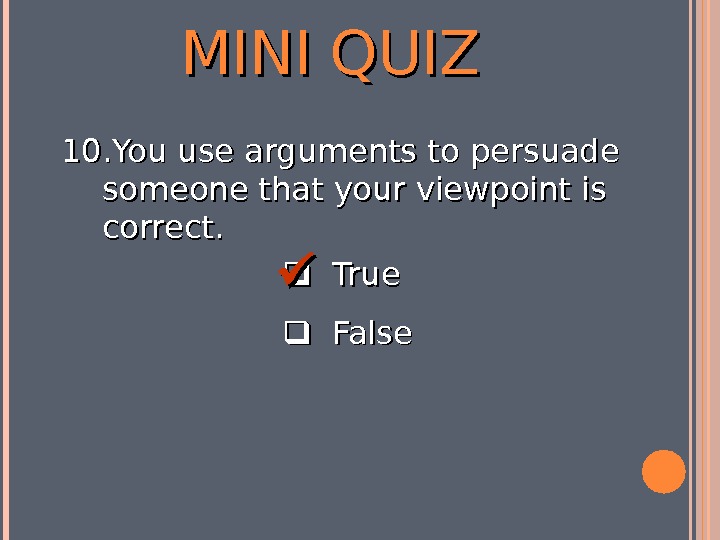
- Размер: 1.9 Mегабайта
- Количество слайдов: 50
Описание презентации SO YOU THINK YOU CAN ARGUE WHAT по слайдам
 SO YOU THINK YOU CAN ARGU
SO YOU THINK YOU CAN ARGU
 WHAT IS AN ARGUMENT?
WHAT IS AN ARGUMENT?
 An An argument is just a statement that someone believes is or should be true. Kids should be in school Monday through Saturday!
An An argument is just a statement that someone believes is or should be true. Kids should be in school Monday through Saturday!
 A A counterargument expresses the opposite point of view. Kids should notnot have to go to school on Saturdays.
A A counterargument expresses the opposite point of view. Kids should notnot have to go to school on Saturdays.
 ““ I NEED BACKUP!” A main argument all by itself is not very strong. Supporting arguments explain why the main argument is true.
““ I NEED BACKUP!” A main argument all by itself is not very strong. Supporting arguments explain why the main argument is true.
 Main Argument Kids should not have to go to school on Saturdays. Supporting Arguments Students need a rest. Most working parents have weekends off, and students need to be with their families. Some students have jobs. Students need time for other activities.
Main Argument Kids should not have to go to school on Saturdays. Supporting Arguments Students need a rest. Most working parents have weekends off, and students need to be with their families. Some students have jobs. Students need time for other activities.
 ARE YOU LABORING UNDER AA Common myths about arguing. MISCONCEPTION? ?
ARE YOU LABORING UNDER AA Common myths about arguing. MISCONCEPTION? ?
 COMMON MYTHS ABOUT ARGUING Myt hh An argument is just people yelling at each other. Realit yy Arguments can be very calm. An argument in writing is silent!
COMMON MYTHS ABOUT ARGUING Myt hh An argument is just people yelling at each other. Realit yy Arguments can be very calm. An argument in writing is silent!
 COMMON MYTHS ABOUT ARGUING Myt hh You have to totally believe in what you are arguing. Realit yy Making an argument has nothing to do with how you feel. (Bet you can think of one reason why school should be on Saturdays…)
COMMON MYTHS ABOUT ARGUING Myt hh You have to totally believe in what you are arguing. Realit yy Making an argument has nothing to do with how you feel. (Bet you can think of one reason why school should be on Saturdays…)
 COMMON MYTHS ABOUT ARGUING Myt hh Every argument has a right and wrong side. Realit yy Most of the time, the two sides of an argument are just different opinions. Neither side is really right or wrong.
COMMON MYTHS ABOUT ARGUING Myt hh Every argument has a right and wrong side. Realit yy Most of the time, the two sides of an argument are just different opinions. Neither side is really right or wrong.
 COMMON MYTHS ABOUT ARGUING Myt hh You can’t be good at arguing unless you can think fast on your feet. Realit yy A lot of great arguing takes place on paper, where you can take as much time as you need to think everything through.
COMMON MYTHS ABOUT ARGUING Myt hh You can’t be good at arguing unless you can think fast on your feet. Realit yy A lot of great arguing takes place on paper, where you can take as much time as you need to think everything through.
 What word do you see inside the word “persuasive”? ____________________________ persuade
What word do you see inside the word “persuasive”? ____________________________ persuade
 What does it mean to “persuade” someone? (A)(A) To disturb someone about something (B)(B) To sweat on someone (C)(C) To convince someone that something is true (D)(D) To cause someone to be confused about something
What does it mean to “persuade” someone? (A)(A) To disturb someone about something (B)(B) To sweat on someone (C)(C) To convince someone that something is true (D)(D) To cause someone to be confused about something
 TWO KINDS OF OF ARGUMENTS
TWO KINDS OF OF ARGUMENTS
 TWO KINDS OF ARGUMENTS Should/Should Not Does/Does Not Argue why something should or should not be true. .
TWO KINDS OF ARGUMENTS Should/Should Not Does/Does Not Argue why something should or should not be true. .
 Should/Should Not Does/Does Not Argue why something should or should not be true. . Argue why something does or does not violate a rule. . TWO KINDS OF ARGUMENTS
Should/Should Not Does/Does Not Argue why something should or should not be true. . Argue why something does or does not violate a rule. . TWO KINDS OF ARGUMENTS
 Should/Should Not Does/Does Not Argue why something should or should not be true. Argue why something does or does not violate a rule. Use this kind of argument when you are arguing your opinion about something. TWO KINDS OF ARGUMENTS
Should/Should Not Does/Does Not Argue why something should or should not be true. Argue why something does or does not violate a rule. Use this kind of argument when you are arguing your opinion about something. TWO KINDS OF ARGUMENTS
 Should/Should Not Does/Does Not Argue why something should or should not be true. Argue why something does or does not violate a rule. Use this kind of argument when you are arguing your opinion about something. Use this kind of argument when there is already a rule in place. TWO KINDS OF ARGUMENTS
Should/Should Not Does/Does Not Argue why something should or should not be true. Argue why something does or does not violate a rule. Use this kind of argument when you are arguing your opinion about something. Use this kind of argument when there is already a rule in place. TWO KINDS OF ARGUMENTS
 Should/Should Not Does/Does Not Argue why something should or should not be true. Argue why something does or does not violate a rule. Use this kind of argument when you are arguing your opinion about something. Use this kind of argument when there is already a rule in place. Example: Should school be held Monday through Saturday? TWO KINDS OF ARGUMENTS
Should/Should Not Does/Does Not Argue why something should or should not be true. Argue why something does or does not violate a rule. Use this kind of argument when you are arguing your opinion about something. Use this kind of argument when there is already a rule in place. Example: Should school be held Monday through Saturday? TWO KINDS OF ARGUMENTS
 Should/Should Not Does/Does Not Argue why something should or should not be true. Argue why something does or does not violate a rule. Use this kind of argument when you are arguing your opinion about something. Use this kind of argument when there is already a rule in place. Example: Should school be held Monday through Saturday? Example: The school rule says no hats. Sarah wore a giant ribbon on her head. Did Sarah break the rule? TWO KINDS OF ARGUMENTS
Should/Should Not Does/Does Not Argue why something should or should not be true. Argue why something does or does not violate a rule. Use this kind of argument when you are arguing your opinion about something. Use this kind of argument when there is already a rule in place. Example: Should school be held Monday through Saturday? Example: The school rule says no hats. Sarah wore a giant ribbon on her head. Did Sarah break the rule? TWO KINDS OF ARGUMENTS
 CREATING MAIN “DOES/DOES NOT” ARGUMENT SS
CREATING MAIN “DOES/DOES NOT” ARGUMENT SS
 LET’S PRACTICE! Your kid sister Sarah attends 2 Cool 4 U Elementary School. The school rules say students are not allowed to wear hats inside the building. The rules say a hat is anything that covers and protects a person’s head. Sarah wore a giant ribbon in her hair and got in trouble for violating the no-hat rule! Did Sarah really violate the rule?
LET’S PRACTICE! Your kid sister Sarah attends 2 Cool 4 U Elementary School. The school rules say students are not allowed to wear hats inside the building. The rules say a hat is anything that covers and protects a person’s head. Sarah wore a giant ribbon in her hair and got in trouble for violating the no-hat rule! Did Sarah really violate the rule?
 There are two possible main arguments: 1)1) Sarah did not violate the rule because her ribbon is not a hat, oror 2)2) Sarah did violate the rule because her ribbon is a hat. What do you think? (Wait—Don’t answer that yet…)
There are two possible main arguments: 1)1) Sarah did not violate the rule because her ribbon is not a hat, oror 2)2) Sarah did violate the rule because her ribbon is a hat. What do you think? (Wait—Don’t answer that yet…)
 Ha! That was a trick question. Making arguments is a skill that you learn. “What you think” doesn’t really matter at all. You should be able to argue for both sides no matter which side you think is right.
Ha! That was a trick question. Making arguments is a skill that you learn. “What you think” doesn’t really matter at all. You should be able to argue for both sides no matter which side you think is right.
 LET’S TRY ANOTHER: The park rules say, “Don’t walk on the grass. ” Misti avoided a neatly-mowed lawn but cut across another mowed area that was mostly weeds. Did Misti violate the rule? The two possible arguments are… 1. 1. ________________________________ ___ __________________________________ __ 2. 2. ________________________________ ___ __________________________________ __ Misti did not violate the rule because she walked on a weedy area, not on the grass. Misti did violate the rule because there was grass in the area where she walked.
LET’S TRY ANOTHER: The park rules say, “Don’t walk on the grass. ” Misti avoided a neatly-mowed lawn but cut across another mowed area that was mostly weeds. Did Misti violate the rule? The two possible arguments are… 1. 1. ________________________________ ___ __________________________________ __ 2. 2. ________________________________ ___ __________________________________ __ Misti did not violate the rule because she walked on a weedy area, not on the grass. Misti did violate the rule because there was grass in the area where she walked.
 AND ANOTHER: The beach rules say “Don’t feed the ducks. ” Jason ate all but the corner of his sandwich, then tossed the last bite to a goose standing nearby. Did Jason violate the rule? The two possible arguments are… 1. 1. ________________________________ ___ __________________________________ __ 2. 2. ________________________________ ___ __________________________________ __ Jason did not violate the rule because a goose is not a duck. Jason did violate the rule because the beach rule means any water bird and a goose is a water bird.
AND ANOTHER: The beach rules say “Don’t feed the ducks. ” Jason ate all but the corner of his sandwich, then tossed the last bite to a goose standing nearby. Did Jason violate the rule? The two possible arguments are… 1. 1. ________________________________ ___ __________________________________ __ 2. 2. ________________________________ ___ __________________________________ __ Jason did not violate the rule because a goose is not a duck. Jason did violate the rule because the beach rule means any water bird and a goose is a water bird.
 DEVELOPIN G G SUPPORTIN G G ARGUMENT SS
DEVELOPIN G G SUPPORTIN G G ARGUMENT SS
 A main argument by itself is not enough. You have to convince people why your main argument is true. You do this by using supporting arguments.
A main argument by itself is not enough. You have to convince people why your main argument is true. You do this by using supporting arguments.
 Next, let’s look at some supporting arguments. You will decide which main argument each supporting argument supports. Ready? HAT OR NOT?
Next, let’s look at some supporting arguments. You will decide which main argument each supporting argument supports. Ready? HAT OR NOT?
 HAT OR NOT? Supporting Argument #1 : : The ribbon is something on her head. School Rule: A hat is anything that covers and protects a person’s head. (A)(A) This argument supports the idea that Sarah did not violate the rule because her ribbon is not a hat. (B)(B) This argument supports the idea that Sarah did violate the rule because her ribbon is a hat.
HAT OR NOT? Supporting Argument #1 : : The ribbon is something on her head. School Rule: A hat is anything that covers and protects a person’s head. (A)(A) This argument supports the idea that Sarah did not violate the rule because her ribbon is not a hat. (B)(B) This argument supports the idea that Sarah did violate the rule because her ribbon is a hat.
 HAT OR NOT? Supporting Argument #2 : : The ribbon is too flimsy to protect Sarah’s head. School Rule: A hat is anything that covers and protects a person’s head. (A)(A) This argument supports the idea that Sarah did not violate the rule because her ribbon is not a hat. (B)(B) This argument supports the idea that Sarah did violate the rule because her ribbon is a hat.
HAT OR NOT? Supporting Argument #2 : : The ribbon is too flimsy to protect Sarah’s head. School Rule: A hat is anything that covers and protects a person’s head. (A)(A) This argument supports the idea that Sarah did not violate the rule because her ribbon is not a hat. (B)(B) This argument supports the idea that Sarah did violate the rule because her ribbon is a hat.
 HAT OR NOT? Supporting Argument #3 : : The ribbon does not cover all of Sarah’s head. School Rule: A hat is anything that covers and protects a person’s head. (A)(A) This argument supports the idea that Sarah did not violate the rule because her ribbon is not a hat. (B)(B) This argument supports the idea that Sarah did violate the rule because her ribbon is a hat.
HAT OR NOT? Supporting Argument #3 : : The ribbon does not cover all of Sarah’s head. School Rule: A hat is anything that covers and protects a person’s head. (A)(A) This argument supports the idea that Sarah did not violate the rule because her ribbon is not a hat. (B)(B) This argument supports the idea that Sarah did violate the rule because her ribbon is a hat.
 HAT OR NOT? Supporting Argument #4 : : The ribbon could protect her head from rain or dust. School Rule: A hat is anything that covers and protects a person’s head. (A)(A) This argument supports the idea that Sarah did not violate the rule because her ribbon is not a hat. (B)(B) This argument supports the idea that Sarah did violate the rule because her ribbon is a hat.
HAT OR NOT? Supporting Argument #4 : : The ribbon could protect her head from rain or dust. School Rule: A hat is anything that covers and protects a person’s head. (A)(A) This argument supports the idea that Sarah did not violate the rule because her ribbon is not a hat. (B)(B) This argument supports the idea that Sarah did violate the rule because her ribbon is a hat.
 HAT OR NOT? Supporting Argument #5 : : The ribbon would not keep Sarah’s head warm. School Rule: A hat is anything that covers and protects a person’s head. (A)(A) This argument supports the idea that Sarah did not violate the rule because her ribbon is not a hat. (B)(B) This argument supports the idea that Sarah did violate the rule because her ribbon is a hat.
HAT OR NOT? Supporting Argument #5 : : The ribbon would not keep Sarah’s head warm. School Rule: A hat is anything that covers and protects a person’s head. (A)(A) This argument supports the idea that Sarah did not violate the rule because her ribbon is not a hat. (B)(B) This argument supports the idea that Sarah did violate the rule because her ribbon is a hat.
 HAT OR NOT? Supporting Argument #6 : : The ribbon covers most of Sarah’s head. School Rule: A hat is anything that covers and protects a person’s head. (A)(A) This argument supports the idea that Sarah did not violate the rule because her ribbon is not a hat. (B)(B) This argument supports the idea that Sarah did violate the rule because her ribbon is a hat.
HAT OR NOT? Supporting Argument #6 : : The ribbon covers most of Sarah’s head. School Rule: A hat is anything that covers and protects a person’s head. (A)(A) This argument supports the idea that Sarah did not violate the rule because her ribbon is not a hat. (B)(B) This argument supports the idea that Sarah did violate the rule because her ribbon is a hat.
 HAT OR NOT? Supporting Argument #7 : : The ribbon could protect Sarah’s head from sunlight. School Rule: A hat is anything that covers and protects a person’s head. (A)(A) This argument supports the idea that Sarah did not violate the rule because her ribbon is not a hat. (B)(B) This argument supports the idea that Sarah did violate the rule because her ribbon is a hat.
HAT OR NOT? Supporting Argument #7 : : The ribbon could protect Sarah’s head from sunlight. School Rule: A hat is anything that covers and protects a person’s head. (A)(A) This argument supports the idea that Sarah did not violate the rule because her ribbon is not a hat. (B)(B) This argument supports the idea that Sarah did violate the rule because her ribbon is a hat.
 HAT OR NOT? Supporting Argument #8 : : The ribbon is not fitted to Sarah’s head. School Rule: A hat is anything that covers and protects a person’s head. (A)(A) This argument supports the idea that Sarah did not violate the rule because her ribbon is not a hat. (B)(B) This argument supports the idea that Sarah did violate the rule because her ribbon is a hat.
HAT OR NOT? Supporting Argument #8 : : The ribbon is not fitted to Sarah’s head. School Rule: A hat is anything that covers and protects a person’s head. (A)(A) This argument supports the idea that Sarah did not violate the rule because her ribbon is not a hat. (B)(B) This argument supports the idea that Sarah did violate the rule because her ribbon is a hat.
 IF YOU’VE SEEN ONE ARGUMENT. . .
IF YOU’VE SEEN ONE ARGUMENT. . .
 … … you have notnot seen them all! Some arguments are better than others. Look at the four arguments below. Which one do you think is the strongest? Weakest? The ribbon is too flimsy to protect Sarah’s head from anything. The ribbon does not cover all of Sarah’s head. The ribbon would not keep Sarah’s head warm. The ribbon is not fitted to Sarah’s head.
… … you have notnot seen them all! Some arguments are better than others. Look at the four arguments below. Which one do you think is the strongest? Weakest? The ribbon is too flimsy to protect Sarah’s head from anything. The ribbon does not cover all of Sarah’s head. The ribbon would not keep Sarah’s head warm. The ribbon is not fitted to Sarah’s head.
 MINI-QUIZ!
MINI-QUIZ!
 MINI QUIZ True False 1. 1. You can only make an argument about something if you feel very strongly about it. Making an argument has nothing to do with how you actually feel. It is a skill you learn.
MINI QUIZ True False 1. 1. You can only make an argument about something if you feel very strongly about it. Making an argument has nothing to do with how you actually feel. It is a skill you learn.
 MINI QUIZ True False 2. 2. Persuasive writing is meant to convince someone that something is true. Exactly! The whole point is to “persuade” someone.
MINI QUIZ True False 2. 2. Persuasive writing is meant to convince someone that something is true. Exactly! The whole point is to “persuade” someone.
 MINI QUIZ True False 3. 3. All arguments are equally strong. Some arguments are stronger and more convincing than others.
MINI QUIZ True False 3. 3. All arguments are equally strong. Some arguments are stronger and more convincing than others.
 MINI QUIZ True False 4. 4. If there is already a rule in place, you will use a should/should not argument. When there is already a rule, you will argue whether something does or does not violate that rule.
MINI QUIZ True False 4. 4. If there is already a rule in place, you will use a should/should not argument. When there is already a rule, you will argue whether something does or does not violate that rule.
 MINI QUIZ True False 5. 5. An argument is a statement that someone claims is or should be true. Whether you’re arguing that Sarah did violate the rule or that students should not go to school on Saturdays, you are claiming that statement is true.
MINI QUIZ True False 5. 5. An argument is a statement that someone claims is or should be true. Whether you’re arguing that Sarah did violate the rule or that students should not go to school on Saturdays, you are claiming that statement is true.
 MINI QUIZ True False 6. 6. An argument can take place without any yelling at all. We’re talking about arguments that are meant to persuade. Yelling won’t help, but good reasoning will.
MINI QUIZ True False 6. 6. An argument can take place without any yelling at all. We’re talking about arguments that are meant to persuade. Yelling won’t help, but good reasoning will.
 MINI QUIZ True False 7. 7. There is a right and wrong side to every argument. Most of the time, the different sides of an argument are just different opinions. However, people may believe very strongly that one side is correct.
MINI QUIZ True False 7. 7. There is a right and wrong side to every argument. Most of the time, the different sides of an argument are just different opinions. However, people may believe very strongly that one side is correct.
 MINI QUIZ True False 8. 8. Sarah looks very cool in her big ribbon. Um… Everyone is entitled to an opinion!
MINI QUIZ True False 8. 8. Sarah looks very cool in her big ribbon. Um… Everyone is entitled to an opinion!
 MINI QUIZ True False 9. 9. People often use persuasive writing when writing letters about important issues.
MINI QUIZ True False 9. 9. People often use persuasive writing when writing letters about important issues.
 MINI QUIZ True False 10. You use arguments to persuade someone that your viewpoint is correct.
MINI QUIZ True False 10. You use arguments to persuade someone that your viewpoint is correct.
